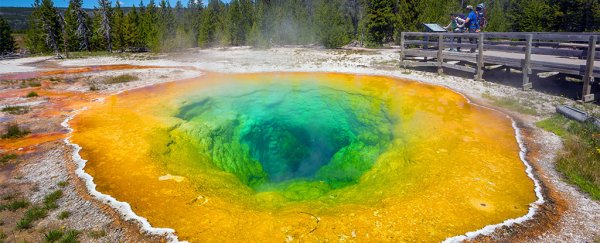Yellowstone National Park may be showing some scary signs of "supervolcanic" activity, but new research has found we don't have to worry just yet. It turns out Yellowstone, along with other supervolcanoes, have very clear signs when an eruption is pending, and Yellowstone is thankfully still in the safe zone.
Although we can do nothing about volcanic eruptions actually occurring, predicting when they are going to occur is a vital part of damage control. When they're close to erupting, they give off signs.
These include hundreds of small earthquakes; rising temperatures around the volcano; and the release of gases. The closer the volcano is to erupting, the more sulphur can be detected in these gases.
But the new study, led by the University of Illinois in the US, has found that there are mechanical tectonic stresses in the lead-up to the catastrophic eruption of a supervolcano - which are technically called caldera forming volcanoes - and that these should be detectable long before such an event takes place.
"Our numerical models show for the first time that the rock surrounding a large magma reservoir is only stable on timescales of centuries to thousands of years when new magma is actively being injected into the magma reservoir," the team wrote in the summary of their paper.
"This finding provides important constraints on the amount of time necessary to recharge and erupt a large, supervolcano size reservoir from the first indication of magmatic activity."
Initially, the team was setting out to investigate region-scale plate tectonic stresses by using computer modelling, but then realised that their work could help geologists recognise what to expect in the lead-up to an eruption.
They found that tectonic stress has a huge effect - but it's not the only contributing factor to a catastrophic eruption.
"It does not matter if it is extensional, compressional or shear stress," said lead author and geologist Haley Cabaniss.
"Any tectonic stress will help destabilise rock and trigger eruptions, just on slightly different timescales. The remarkable thing we found is that the timing seems to depend not only on tectonic stress, but also on whether magma is being actively supplied to the volcano."
The team focused their modelling on the Taupo volcanic zone in New Zealand, because its tectonic zone is relatively uncomplicated, and usually associated with supervolcanoes.
They adjusted parameters such as the amount of tectonic stress, tectonic movement and magma supply - and found that, in any of the tectonic settings they modelled, supervolcano magma reservoirs remain stable for hundreds to thousands of years while being actively supplied with magma.
That's actually a very small amount of time on the geologic scale - but volcanoes can remain dormant for a very long time without active magma supply, the researchers said.
"Supervolcanoes can lay dormant for a very long time, sometimes a million years or more," explained co-author Patricia Gregg, a geologist at the university.
"In other words, they may remain stable, doing almost nothing for 999,000 years, then start a period of rejuvenation leading to a large-scale eruption."
The research suggests that huge geologic disruption occurs before a super-eruption, due to the supply of new magma to the volcanic system.
And, while Yellowstone has been showing signs of activity, it's nothing close to what the researchers expect for a big eruption, the most recent of which was 640,000 years ago (the most recent lava flow in Yellowstone was 70,000 years ago).
"When new magma starts to rejuvenate a supervolcano system, we can expect to see massive uplift, faulting and earthquake activity," Gregg said.
"Far greater than the meter-scale events we have seen in recent time. We are talking on the range of tens to hundreds of meters of uplift. Even then, our models predict that the system would inflate for hundreds to thousands of years before we witness catastrophic eruption."
This is consistent with what geologists said earlier this year, when unusually active geysers in Yellowstone made headlines.
"There is nothing to indicate that any sort of volcanic eruption is imminent," Michael Poland, the scientist in charge of the US Geological Survey's Yellowstone Volcano Observatory, told Reuters.
"Our research suggests that the whole rejuvenation-to-eruption process will take place over several or more human lifetimes," Cabaniss said. "Our models indicate that there should be plenty of warning."
The research has been published in the journal Geophysical Research Letters.
